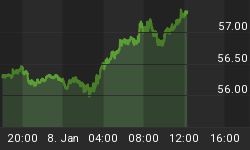All you worried goldbugs out there, repeat after me: Corrections happen. Every bull market has lots of 5%-10% squiggles that look like the end of the world to those who don't understand, and like entry points to those who do.
GoldMoney's James Turk devotes a page of his latest FreeMarket Gold & Money Report to the proposition that the secular bull market in precious metals (and the secular decline in the dollar) is alive and well. Here's some of what James had to say:
Both gold and silver were hit hard this past week. It's the same story we have seen many times before. As gold climbed in price, we witnessed in recent weeks the huge build-up of open interest on the Comex. The gold cartel, which is a group of bullion banks acting under the direction of the US government, was selling whatever paper promises (i.e., futures contracts, which are simply paper representations of gold but not gold itself) it felt were needed to try slowing and then capping gold's advance.
The weekly reports prepared by the Commodity Futures Trading Commission clearly show this intervention. The CFTC reports all short positions based on the size of the firms that hold them, and some large firms are members of the gold cartel. So the huge jump in the short positions of the large commercial firms reveals the gold cartel's handiwork. After throwing enough paper at the market, the gold cartel finally succeeded in capping gold. They were unsuccessful in the $640s and $660s, but after adding thousands of futures contracts that caused open interest to balloon to new highs, the gold cartel stopped gold in the $680s.
Then the rout began. Gold dropped four days-in-a-row, losing $45 or 6.6% in the process. Fortunately, there was no serious long-term technical damage to gold's chart - nor do I expect any in the days and weeks ahead. Any reversal of gold's major uptrend is unlikely because the gold cartel is already covering short positions at these prices, which will provide underlying support for gold. More importantly, the same fundamental factors that have been driving gold higher for years remain in place.
In fact, the volatility in the stock market and growing nervousness about asset quality of the banks and brokers involved with sub-prime mortgages is another reason to own gold. Their deteriorating asset quality means that a financial panic is becoming increasing likely, and could perhaps be similar to any of those panics we saw in the 1980s as banks collapsed because of imprudent loans.
The gold market doesn't need a financial panic to climb higher. Gold remains well below the price it would be trading if government-led gold cartel wasn't regularly intervening to keep gold as low as it can. But we can take solace from the fact that gold is in a long-term uptrend, clearly indicating that the gold cartel is losing the war.
Turning to the above gold chart, I draw attention again to the two red circles that I have been mentioning in recent letters. But note that I have also added two red rectangles to this chart. Note what happened to gold back in 2005 after breaking out from the first red circle. It shot up, and then went into a severe downdraft. It was another gold cartel attack, but gold quickly reversed and continued within the major uptrend then underway.
Will the same pattern repeat? No one of course knows, but readers of these letters know that I always put a lot of emphasis on past results. Markets often do repeat, etching out similar trading patterns on the charts. So if history does repeat, we are at or near the low, and gold will rocket higher from here. The gold cartel has probably taken gold as low as they can on this move because it deals primarily in the paper gold market. Right now the demand for physical gold is strong, and these buyers don't want paper promises from the gold cartel. They want metal. The gold cartel only dishoards gold from central bank coffers sparingly. They prefer to threaten dishoarding rather than actually do it, because they recognize that their gold is essential, so they only part with it reluctantly and infrequently. Consequently, the physical gold demanded by buyers in China and elsewhere throughout the world has to come from somewhere. It comes from people who already own it, but are only willing to part with it at a higher price. So either dishoarded central bank gold or higher prices are needed to keep the market in balance, i.e., the price of physical gold consistent with the price of paper gold.
Even though I have been and remain bullish, in the last letter I advised not to "go out and bet the ranch" because the "gold cartel has been out in force, trying to cap the gold price." In other words, I do not recommend using leverage if you choose to trade gold (i.e., trying to profit from its price fluctuations, in contrast to the long-term wealth accumulation strategy of buying gold month-in and month-out). Leverage is dangerous, as we saw over the past four days. No doubt there were a lot of margin calls issued, with the consequence that there was much forced selling. But the capping by the gold cartel and the subsequent rush for liquidity does not diminish gold's long-term prospects, a fact no doubt understood by the long-term accumulators of physical metal who now find gold significantly cheaper than it was just a short week ago.
Gold did not reach my $720 target by the end of February. But I expect that we will see that price soon enough, probably within the next two months.

















